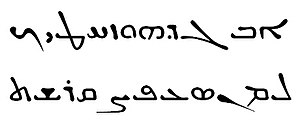الفرق بين النسختين بتاع: «سيريانى»
تم حذف المحتوى تمت إضافة المحتوى
ص تزويد قوالب توماتيكى و/او تظبيط عن طريق اوب |
HitomiAkane (مناقشه | تعديلات) تصليج خطأ مرجع |
||
| سطر 6: | سطر 6: | ||
| image_size = 200px |
| image_size = 200px |
||
| imagecaption = '''Leššānā Suryāyā''' in written Syriac (Esṭrangelā script) |
| imagecaption = '''Leššānā Suryāyā''' in written Syriac (Esṭrangelā script) |
||
| region = [[Mesopotamia]] (ancient [[Iraq]]), northeastern [[Syria]], southeastern [[Turkey]], northwestern [[Iran]],<ref>{{Cite web | url=https://www.arch.cam.ac.uk/about-us/mesopotamia/mesopotamia-history/mesopotamia-languages |title = Mesopotamian Languages — Department of Archaeology}}</ref><ref>{{Cite web | url=http://www.bbc.co.uk/history/ancient/cultures/mesopotamia_gallery_01.shtml |title = BBC - History - Ancient History in depth: Mesopotamia}}</ref> [[Eastern Arabia]], [[Fertile Crescent]] |
| region = [[Mesopotamia]] (ancient [[Iraq]]), northeastern [[Syria]], southeastern [[Turkey]], northwestern [[Iran]],<ref>{{Cite web | url=https://www.arch.cam.ac.uk/about-us/mesopotamia/mesopotamia-history/mesopotamia-languages |title = Mesopotamian Languages — Department of Archaeology}}</ref><ref>{{Cite web | url=http://www.bbc.co.uk/history/ancient/cultures/mesopotamia_gallery_01.shtml |title = BBC - History - Ancient History in depth: Mesopotamia}}</ref> [[Eastern Arabia]], [[Fertile Crescent]] |
||
| era = 1st century AD; Dramatically declined as a [[vernacular language]] after the 14th century; Developed into [[Northeastern Neo-Aramaic]] and [[Central Neo-Aramaic]] languages after the 12th century. |
| era = 1st century AD; Dramatically declined as a [[vernacular language]] after the 14th century; Developed into [[Northeastern Neo-Aramaic]] and [[Central Neo-Aramaic]] languages after the 12th century. |
||
| ref = <ref name=Angold391>{{Harvnb |Angold|2006|pp=391}}</ref> |
| ref = <ref name=Angold391>{{Harvnb |Angold|2006|pp=391}}</ref> |
||
تعديلات من 16:54، 8 نوفمبر 2019
| سيريانى | |
|---|---|
| ܠܫܢܐ ܣܘܪܝܝܐ Leššānā Suryāyā | |
Leššānā Suryāyā in written Syriac (Esṭrangelā script) | |
| Pronunciation | lɛʃʃɑːnɑː surjɑːjɑː |
| Region | Mesopotamia (ancient Iraq), northeastern Syria, southeastern Turkey, northwestern Iran,[1][2] Eastern Arabia, Fertile Crescent |
| Era | 1st century AD; Dramatically declined as a vernacular language after the 14th century; Developed into Northeastern Neo-Aramaic and Central Neo-Aramaic languages after the 12th century.[3] |
| Syriac abjad | |
| Official status | |
Recognised minority language in |
(Recognized language and a constitutional right to educate in the mother tongue language)[4][5]
|
| Language codes | |
| ISO 639-2 | syc Classical Syriac |
| ISO 639-3 | syc Classical Syriac |
| Glottolog | clas1252 |

لغه سيريانى (سيريانى: ܠܫܢܐ ܣܘܪܝܝܐ), كانت لغه منتشره بسوريا, توركيا, والعراق, وبتحديد جنوب وشمال ميسوبوتاميا, ودى كانت لغه غالبيه لمسيحيين فى شرق منطقة الشرق الاوسط, وعدت آسيا الوسطانى وبعض مناطق الهند. ولغة السيريانى ده وحده من جروب لهجات الأراميه, والأرامى ده لغه من جروب لغات الساميه.
مصادر
- ↑ "Mesopotamian Languages — Department of Archaeology".
- ↑ "BBC - History - Ancient History in depth: Mesopotamia".
- ↑ خطأ: الوظيفة "harvard_citation_no_bracket" غير موجودة.
- ↑ https://www.constituteproject.org/constitution/Iraq_2005.pdf?lang=en
- ↑ http://www.turkmen.nl/1A_Others/minority-Iraq.pdf
- ↑ "Kurdistan: Constitution of the Iraqi Kurdistan Region". Retrieved 14 April 2019.


